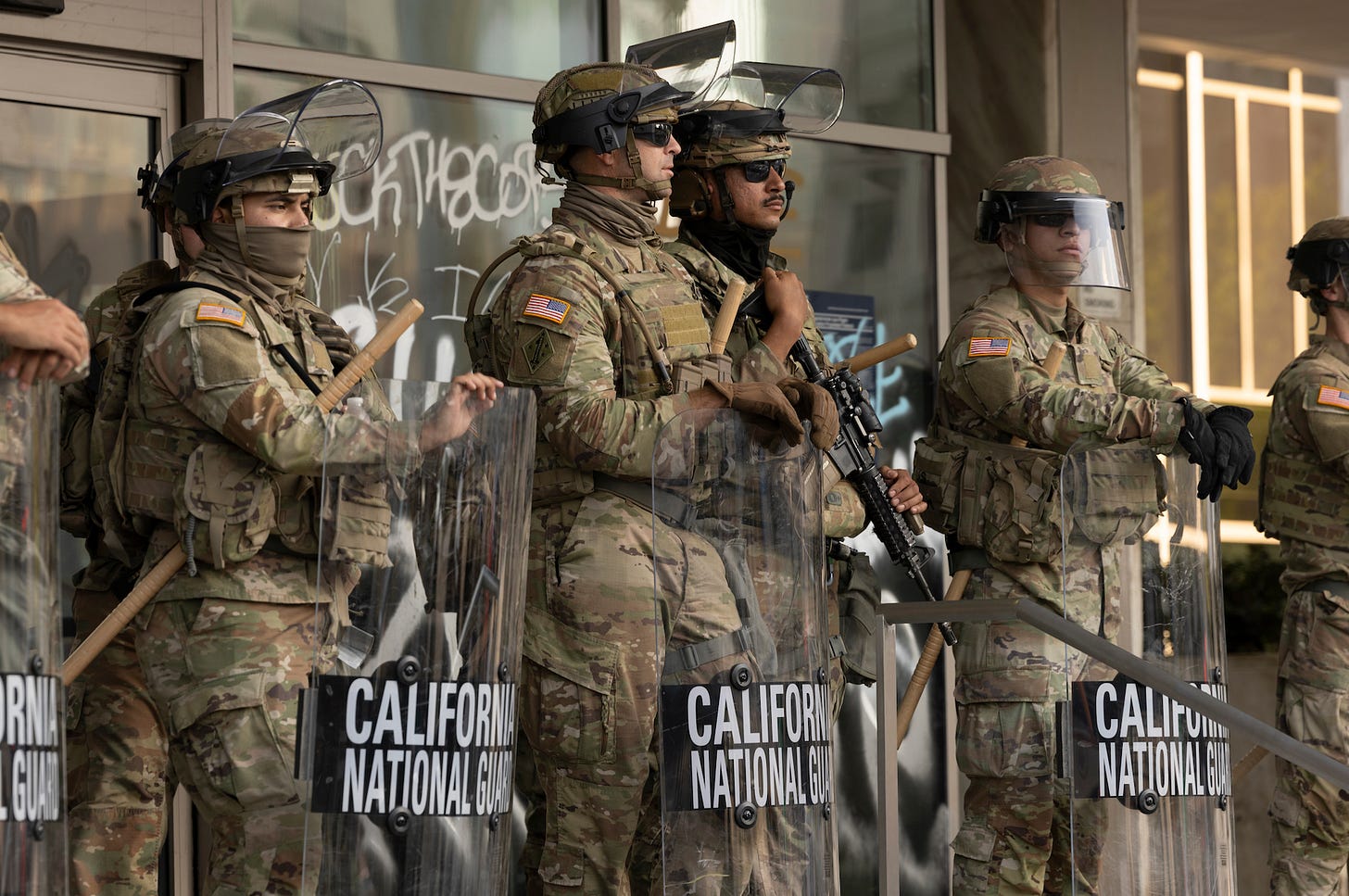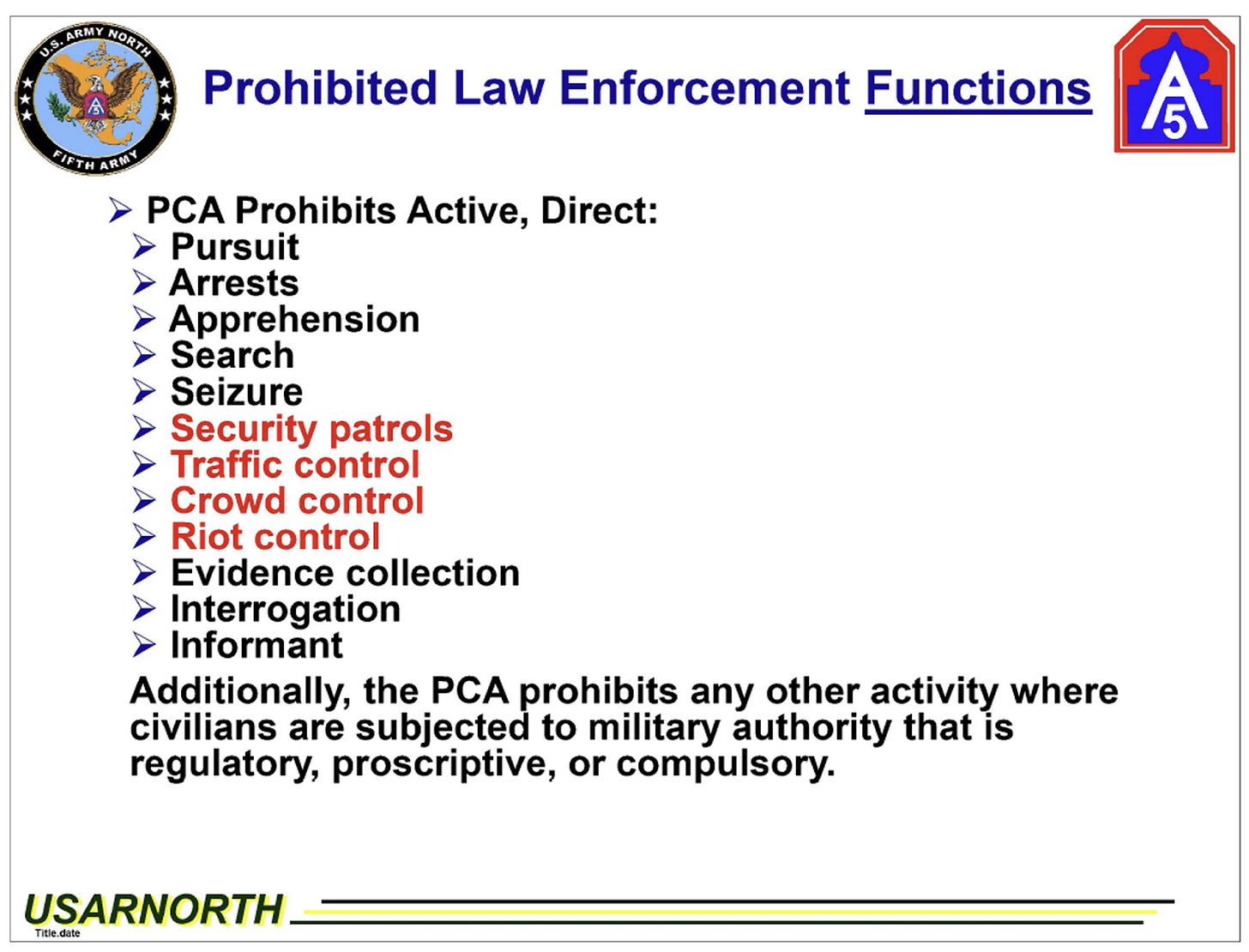Court Smacks Down Trump's Roving Military Police Force
If it walks like a posse comitatus, and it quacks like a posse comitatus ...
On Tuesday, Judge Charles Breyer ordered the Trump administration to quit violating the Posse Comitatus Act (PCA). The court found that the Defense Department illegally used Marines and federalized National Guard troops to enforce civil law during a surge of immigration raids in and around Los Angeles in June and July. Worse still, Secretary of Defense Pete Hegseth and his minions deliberately countermanded their own instruction materials to authorize illegal conduct.
“Defendants knew that they were ordering troops to execute domestic law beyond their usual authority,” Judge Breyer wrote, concluding that “Defendants’ systemic use of Task Force 51 troops to execute domestic law in and around Los Angeles violated the Posse Comitatus Act.”
Judge Breyer is clearly aware of the stakes.
“Los Angeles was the first U.S. city where President Trump and Secretary Hegseth deployed troops, but not the last,” he wrote, noting that National Guard troops have descended on Washington DC to “stand with their law enforcement partners.” Even today Trump is threatening to send troops to Oakland, Baltimore, Chicago, and San Francisco to “clean up” those cities as well.
And so the jurist took pains to explain why erecting a cordon and shutting down streets amount to domestic law enforcement, and not simply “protecting” ICE and DHS agents. Parading through MacArthur Park in full battle rattle to demonstrate “presence” is less of a close call.
The opinion serves as a roadmap for states and federal judges when the “national police force with the President as its chief” rolls onto their streets. And so, of course, the administration is trying to stick a shiv in it, immediately filing an emergency motion to stay during its appeal.
Background
Newsom v. Trump has followed a weird procedural trajectory. After a few hours of anti-ICE rioting which was quickly quelled by police, Trump seized on the “emergency” as justification to federalize the California National Guard over the objections of Governor Gavin Newsom. The state sued, alleging that there was no emergency, the Guard had been illegally federalized, and that the Guard and Marines were grossly violating the PCA.
Judge Breyer issued a temporary restraining order as to the first two issues, rubbishing the so-called “emergency” of a few kids throwing rocks and ruling that 10 USC § 12406’s requirement that the Guard be federalized “through” the governor did not allow for Hegseth to unilaterally deploy them. But the trial judge saved the issue of the PCA for the preliminary injunction stage, reasoning that a couple of weeks of troops on the ground would yield evidence relevant to the PCA issue.
The administration immediately appealed the (unappealable) TRO, as is its habit. And a Ninth Circuit panel, which contained two Trump appointees, ultimately reversed Judge Breyer’s TRO with respect to the emergency declaration and the federalization under § 12406, staying the order pending appeal.
But that left the issue of the PCA unresolved, and so Judge Breyer held a three-day bench trial in August to determine whether the Trump administration was using “any part of the Army, the Navy, the Marine Corps, the Air Force, or the Space Force as a posse comitatus or otherwise to execute the laws.”
The law doesn’t count if you cross it out?
As Judge Breyer explained, the PCA issue turns on whether troops “actively assisted with the execution of domestic law,” or “whether the military’s involvement is so indirect as to not violate the Act.”
Luckily, the Defense Department produced a handy-dandy PCA training manual for the “Task Force 51” troops deployed to Los Angeles. Less luckily (for the government defendants), they seem to have taken a giant Sharpie to it, crossing out stuff they really wanted to do anyway.
Here’s the PowerPoint slide of “Prohibited Law Enforcement Functions” entered into evidence. It explains that the PCA prohibits twelve categories of actions: pursuit, arrests, apprehension, search, seizure, security patrols, traffic control, crowd control, riot control, evidence collection, interrogation, and serving as an informant.
But four of those — establishing security patrols, traffic control, crowd control, and riot control — were rendered in red. That’s because troops were “orally instructed” that those four were part of a “so-called constitutional exception to the Posse Comitatus Act.”
There is no such “constitutional exception.” As Judge Breyer noted, “This assertion is not grounded in the history of the Act, Supreme Court jurisprudence on executive authority, or common sense.”
And so the Defense Department tried hard — albeit ineffectively — to hide what they were doing.
“This instruction was initially not put in writing,” the court observed dryly. But on June 23, Hegseth sent out a memo authorizing “measures for temporary detention, cursory search, and the steps necessary to ensure the safety of Federal personnel” including “perimeter protection against third parties and such crowd control measures as are reasonably necessary to ensure the execution of Federal functions and the safety of Federal personnel.”
In short, “Task Force 51 troops were openly instructed that they could, consistent with the Posse Comitatus Act, engage in some law enforcement actions as long as they were doing so to protect federal property, personnel, or functions.”
And engage in them, they did.
TL, DR: If you’d otherwise have ICE agents or cops doing it, it’s law enforcement
After Hegseth’s memo and the green light from the Ninth Circuit, the Task Force 51 troops were deployed as virtual bodyguards for ICE, blocking streets and forming cordons for every law enforcement action. They even participated in a chest thumping military parade through MacArthur Park, using Humvees and tactical vehicles to block traffic along Wilshire Boulevard as part of Hegseth’s plan “to demonstrate, through a show of presence, the capacity and freedom of maneuver of federal law enforcement within the Los Angeles Joint Operations Area.”
Judge Breyer held that all of this violated the PCA. He also rejected a truly bizarre claim made by the DOJ that § 12406 is an exception to the PCA, so the federalized troops were free to act as a roving police force.
“The Court is unaware of any person—government lawyer, military or civilian official, court, or commentator—who has made this argument other than Defendants’ lawyers in this case,” he scoffed. “The Department of Defense has not taken this position in its publications on the Posse Comitatus Act.” The court did, however partially excuse the DOJ’s bonkers argument, chalking it up as the “consequences of the Ninth Circuit’s highly deferential reading of the statute.” (Shaaaaaaade.)
Judge Breyer laid out three metrics to assess whether a particular military action complies with the PCA’s ban on using the military to “execute the laws.” It is more likely that an activity violates the PCA if it involves:
Troops engages in direct law enforcement functions, such as “setting up protective perimeters, traffic blockades, crowd control, and the like”;
Coordinated, ongoing activities as opposed to isolated, passive ones; and
Actions taken without the support of state and local law enforcement, particularly when troops are used as a substitute for security that local police would otherwise proved.
Here, there’s ample evidence of all three.
Task Force 51 routinely blockaded the roads and “used riot shields and military vehicles to establish a perimeter at the DEA enforcement operation” at a marijuana farm in Mecca, California. It mustered in advance of ICE actions, not as a response to actual violence or protest, but to discourage it and impede the movement of people into and out of the area.
It performed functions that would otherwise have been carried out by ICE agents or local law enforcement. Even some of the government’s witnesses were “unable to distinguish” Task Force 51 troops from ICE agents in photos of joint actions.
And, once the troops were on the ground, ICE virtually ceased cooperating with the Los Angeles Police and Sheriffs Departments.
Even though multiple federal agencies and Task Force 51 rehearsed Operation Excalibur several times, they provided LAPD and LASD with a mere two hours’ notice of the operation. Likewise, federal agencies notified local law enforcement of cannabis farm raids only at the time of the raids, not beforehand. This is not typical. In those Posse Comitatus Act cases where state and local law enforcement had jurisdiction… federal troops generally worked alongside state and local officials. Defendants’ lack of cooperation with their state and local counterparts raises red flags. It also highlights the lack of any showing by Defendants that state and local officials were unable or unwilling to execute the laws before Defendants deployed troops to engage in typical law enforcement functions.
The court’s conclusion was inescapable: “Defendants instigated a months-long deployment of the National Guard and Marines to Los Angeles for the purpose of establishing a military presence there and enforcing federal law. Such conduct is a serious violation of the Posse Comitatus Act.”
Avenues of attack
This case is clearly headed to the Supreme Court. Trump is fixated on unleashing the military on Democratic cities, and he knows that the six conservative justices are largely supine to the “unitary executive” — if only when that executive is a Republican.
Even if the Court does wind up ruling against him, the administration can likely wrangle many more months of delay from a Court-imposed stay, during which time the military will be allowed to run riot in Democratic strongholds. Hell, if DOJ times this thing right, they might be able to drag this out until November of 2026, so Trump can flood the swing states with troops during the election.
But if the Supreme Court wants to avoid the issue, they might kick this case on standing grounds. The Posse Comitatus Act, codified at 18 USC § 1385 is a criminal statute that doesn’t on its face allow for civil actions to enforce it. Judge Breyer found that California had equitable standing to sue the Trump administration because having troops on the street conducting domestic law enforcement infringes on the “quintessential power that the Constitution reserves to the states,” that is, the state’s police power to enforce its own laws. It is not hard to imagine the Court’s howler monkey wing seizing on standing as a convenient excuse to let the Trump administration to continue flagrantly violating the law.
But for now, we wait for the Ninth Circuit. Judge Breyer stayed his order until September 12, and so we get to spend the week playing the Laws, Do They Even Matter? game. Again.






So in Chicago they’re gonna get around the PCA by just planting ICE thugs on the navy base there and pretending they’re doing immigration enforcement. Hope this can be stopped somehow.
…and dictator says: oh well, no is no i’m not going to do it